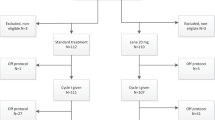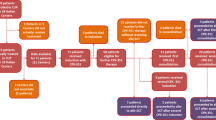Abstract
Combination chemotherapy may induce remission from acute myeloid leukemia (AML), but validated criteria for treatment of elderly are lacking. The remission intention (RI) rate for elderly patients, as reported to the Swedish Leukemia Registry, was known to be different when comparing the six health care regions, but the consequences of different management are unknown. The Leukemia Registry, containing 1672 AML patients diagnosed between 1997 and 2001, with 98% coverage and a median follow-up of 4 years, was completed with data from the compulsory cancer and population registries. Among 506 treated and untreated patients aged 70–79 years with AML (non-APL), there was a direct correlation between the RI rate in each health region (range 36–76%) and the two-year overall survival, with no censored observations (6–21%) (χ2 for trend=11.3, P<0.001; r2=0.86, P<0.02, nonparametric). A 1-month landmark analysis showed significantly better survival in regions with higher RI rates (P=0.003). Differences could not be explained by demographics, and was found in both de novo and secondary leukemias. The 5-year survival of the overall population aged 70–79 years was similar between the regions. Survival of 70–79-year-old AML patients is better in regions where more elderly patients are judged eligible for remission induction.
This is a preview of subscription content, access via your institution
Access options
Subscribe to this journal
Receive 12 print issues and online access
$259.00 per year
only $21.58 per issue
Buy this article
- Purchase on Springer Link
- Instant access to full article PDF
Prices may be subject to local taxes which are calculated during checkout




Similar content being viewed by others
References
Hiddemann W, Kern W, Schoch C, Fonatsch C, Heinecke A, Wormann B et al. Management of acute myeloid leukemia in elderly patients. J Clin Oncol 1999; 17: 3569–3576.
Löwenberg B, Downing JR, Burnett A . Acute myeloid leukemia. N Engl J Med 1999; 341: 1051–1062.
Burnett AK, Wheatley K, Goldstone AH, Gibson B, Webb D, Prentice AG et al. MRC AML12: a comparison of ADE vs MAE and S-DAT vs H-DAT±retinoic acid for induction and four vs five total courses using chemotherapy or stem cell transplantation in consolidation, in 3459 patients under 60 years with AML. Blood 2002; 100 (11(suppl)): 155a.
Hann IM, Stevens RF, Goldstone AH, Rees JK, Wheatley K, Gray RG et al. Randomized comparison of DAT versus ADE as induction chemotherapy in children and younger adults with acute myeloid leukaemia. Results of the Medical Research Council's 10th AML trial (MRC AML10). Adult and Childhood Leukaemia Working Parties of the Medical Research Council. Blood 1997; 89: 2311–2318.
Hiddemann W, Aul C, Maschmeyer G, Schonrock-Nabulsi R, Ludwig WD, Bartholomaus A et al. High-dose versus intermediate dose cytosine arabinoside combined with mitoxantrone for the treatment of relapsed and refractory acute myeloid leukemia: results of an age adjusted randomized comparison. Leuk Lymphoma 1993; 10 (Suppl): 133–137.
Lowenberg B, Zittoun R, Kerkhofs H, Jehn U, Abels J, Debusscher L et al. On the value of intensive remission-induction chemotherapy in elderly patients of 65+ years with acute myeloid leukemia: a randomized phase III study of the European Organization for Research and Treatment of Cancer Leukemia Group. J Clin Oncol 1989; 7: 1268–1274.
Stone RM, Berg DT, George SL, Dodge RK, Paciucci PA, Schulman P et al. Granulocyte-macrophage colony-stimulating factor after initial chemotherapy for elderly patients with primary acute myelogeneous leukemia. N Engl J Med 1995; 332: 1671–1677.
Lowenberg B, Suciu S, Archimbaud E, Ossenkoppele G, Verhoef GE, Vellenga E et al. Use of recombinant GM-CSF during and after remission induction chemotherapy in patients aged 61 years and older with acute myeloid leukemia: final report of AML-11, a phase III randomized study of the Leukemia Cooperative Group of European Organisation for the Research and Treatment of Cancer and the Dutch Belgian Hemato-Oncology Cooperative Group. Blood 1997; 90: 2952–2961.
Goldstone AH, Burnett AK, Wheatley K, Smith AG, Hutchinson RM, Clark RE . Attempts to improve treatment outcomes in acute myeloid leukemia (AML) in older patients: the results of the United Kingdom Medical Research Council AML11 trial. Blood 2001; 98: 1302–1311.
Wahlin A, Markevärn B, Golovleva I, Nilsson M . Prognostic significance of risk group stratification in elderly patients with acute myeloid leukaemia. Br J Haematol 2001; 115: 25–33.
DeLima M, Ghaddar H, Pierce S, Estey E . Treatment of newly-diagnosed acute myelogeneous leukaemia in patients aged 80 years and above. Br J Haematol 1996; 93: 89–95.
Ferrara F, Mirto S, Zagonel V, Pinto A . Acute myeloid leukemia in the elderly: a critical review of therapeutic approaches and appraisal of results of therapy. Leuk Lymph 1998; 29: 375–382.
Di Febo A, Mele L, Fianchi L, Scardocci A, Voso MT, Falcucci P et al. Acute myeloid leukemia in elderly patients aged over 75 years: experience of a single centre. Leuk Lymph 2003; 44: 1441–1443.
Leith CP, Kopecky KJ, Godwin J, McConnell T, Slovak ML, Chen IM et al. Acute myeloid leukemia in the elderly: assessment of multidrug resistance (MDR1) and cytogenetics distinguishes biologic subgroups with remarkably distinct responses to standard chemotherapy. A Southwest Oncology Group study. Blood 1997; 89: 3323–3329.
Grimwade D, Walker H, Harrison G, Oliver F, Chatters S, Harrison CJ et al, MRC Adult Leukemia Working Party. The predictive value of hierarchial cytogenetic classification of older adults with acute myeloid leukemia (AML): analysis of 1065 patients entered into the United Kingdom Medical Research Council AML11 trial. Blood 2001; 98: 1312–1320.
Estey EH . How I treat older patients with AML. Blood 2000; 96: 1670–1673.
Stone RM . The difficult problem of acute myeloid leukemia in the older adult. CA Cancer J Clin 2002; 52: 363–371.
Mengis C, Aebi S, Tobler A, Dähler W, Fey MF . Assessment of differences in patient populations selected for or excluded from participation in clinical phase III acute myelogeneous leukemia trials. J Clin Oncol 2003; 21: 3933–3939.
Billström R, Arnesson C, Möller TR, for the National Registry Group. [Swedish National Registration of Acute Leukemia in Adults. Report #1]. Regional Oncology Center South: Lund, 1998.
Billström R, Arnesson C, Möller TR, for the National Registry Group. [Swedish National Registration of Acute Leukemia in Adults. Report #2]. Regional Oncology Centre South: Lund, 1999.
Billström R, Höglund M, Hellström-Lindberg E, Gruber A, Karlsson K, Juliusson G et al. [Swedish National Registration of Acute Leukemia in Adults. Report #3]. Regional Oncology Centre South: Lund, 2002.
Åström M, Bodin L, Tidefelt U . Adjustment of incidence rates after an estimate of completeness and accuracy in registration of acute leukemias in a Swedish population. Leuk Lymph 2001; 41: 559–570.
Anderson JE, Kopecky KJ, Willman CL, Head D, O'Donnell MR, Luthard FW et al. Outcome after induction chemotherapy for older patients with acute myeloid leukemia is not improved with mitoxantrone and etoposide compared to cytarabine and daunorubicin: a Southwest Oncology Group study. Blood 2002; 100: 3869–3876.
Wheatley K, Burnett AK, Goldstone AH, Gray RG, Hann IM, Harrison CJ et al. A simple, robust, validated and highly predictive index for the determination of risk-directed therapy in acute myeloid leukaemia derived from the MRC AML 10 trial. Br J Haematol 1999; 107: 69–79.
Baer MR, George SL, Dodge RK, O'Loughlin KL, Minderman H, Caliguri MA et al. Phase 3 study of the multidrug resistance modulator PSC-833 in previously untreated patients 60 years of age and older with acute myeloid leukemia: Cancer and Leukemia Group B Study 9720. Blood 2002; 100: 1224–1232.
Rowe JM, Neuberg D, Friedenberg W, Bennett JM, Paietta E, Makary AZ et al. A phase 3 study of three induction regimens and of priming with GM-CSF in older adults with acute myeloid leukemia: a trial by the Eastern Cooperative Oncology Group. Blood 2004; 103: 479–485.
Juliusson G, Höglund M, Karlsson K, Löfgren C, Möllgård L, Paul C, et al., for the Leukemia Group of Middle Sweden. Increased remissions from one course for intermediate-dose cytosine arabinoside and idarubicin in elderly acute myeloid leukemia when combined with cladribine. A randomized population-based phase II study. Br J Haematol 2003; 123: 810–818.
Acknowledgements
The Register is supported by the Swedish National Board of Health and Welfare. GJ is chairman of the acute leukemia registry group and mainly responsible for the analyses and is the author of the manuscript. RB was chairman of the registry from 1996 to 2002. RB, AG, EH-L, MH, KK, AW, and MÅ are MDs and regional clinical representatives of the registry; CA, UB-A, EF, EH, KN, and FW are regional data managers at the regional oncology centers; DS is chairman of the Swedish Society of Hematology; JC is a professor of biostatistics. GJ is a professor at the Lund Strategic Research Center for Stem Cell Biology and Cell Therapy.
Author information
Authors and Affiliations
Consortia
Corresponding author
Rights and permissions
About this article
Cite this article
Juliusson, G., Billström, R., Gruber, A. et al. Attitude towards remission induction for elderly patients with acute myeloid leukemia influences survival. Leukemia 20, 42–47 (2006). https://doi.org/10.1038/sj.leu.2404004
Received:
Revised:
Accepted:
Published:
Issue Date:
DOI: https://doi.org/10.1038/sj.leu.2404004
Keywords
This article is cited by
-
Different treatment strategies versus a common standard arm (CSA) in patients with newly diagnosed AML over the age of 60 years: a randomized German inter-group study
Annals of Hematology (2023)
-
Targeting chemotherapy-resistant leukemia by combining DNT cellular therapy with conventional chemotherapy
Journal of Experimental & Clinical Cancer Research (2018)
-
Outcomes of previously untreated elderly patients with AML: a propensity score-matched comparison of clofarabine vs. FLAG
Annals of Hematology (2018)
-
Acute myeloid leukaemia
Nature Reviews Disease Primers (2016)
-
A randomised comparison of the novel nucleoside analogue sapacitabine with low-dose cytarabine in older patients with acute myeloid leukaemia
Leukemia (2015)



